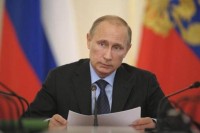
the Russian rouble ended 2014 in bad shape. For most of 2014, Russia faced ever-increasing economic sanctions which set the stage for what was to come late in the year: the collapse of oil prices and the announcement on Nov 10 that the ruble would be allowed to float. When it was allowed to do so, the currency sank like a stone.
In addition to witnessing most of the ruble’s purchasing power vanish, Russians saw the volatility of their currency explode. Not a pretty picture, but one that can be brought into some focus by reflecting on the Indonesian financial crisis of 1997-98.
On Aug 14, 1997, shortly after the Thai baht collapsed on July 2, Indonesia floated the rupiah. Stanley Fischer, Deputy Managing Director of the International Monetary Fund, proclaimed that: “The floating of the rupiah, in combination with Indonesia’s strong fundamentals, supported by prudent fiscal and monetary policies, will allow its economy to continue its impressive economic performance of the last several years.”
If Russia wants to avoid further currency turmoil, further impoverishment of its citizens, and potential political upheavals, it should tether the ruble tightly to the dollar.
Contrary to the IMF’s expectations, the rupiah did not float on a sea of tranquility. It plunged from 2,700 per U.S. dollar to lows of nearly 16,000 in 1998.
By late Jan 1998, President Suharto realized that the IMF medicine was not working and sought a second opinion. In February, Suharto invited me to become his Special Counselor. Although I had no opinions on the Suharto government, I had definite ones on the matter at hand.
The antidote I proposed was an orthodox currency board in which the rupiah would be fully convertible into U.S. dollars at a fixed rate. On the day that news hit the street, the rupiah soared 28 percent against the dollar. It seemed to infuriate the U.S. government and the IMF and ruthless attacks on the idea ensued.
Suharto was told in no uncertain terms that he would have to drop the idea or forgo US$43-billion in foreign assistance. Economists jumped on the bandwagon too. Every half-truth imaginable was trotted out against the currency board, which had nevertheless garnered full support from four Nobel Laureates in Economics: Gary Becker, Milton Friedman, Merton Miller, and Robert Mundell.
Why all the fuss? Miller understood. He wrote to tell me that the U.S. objection to the currency board was “not that it wouldn’t work but that it would, and if it worked, they would be stuck with Suharto.”
Former U.S. Secretary of State Lawrence Eagleberger offered a similar diagnosis: “We were fairly clever in that we supported the IMF as it overthrew [Suharto]. Whether that was a wise way to proceed is another question. I’m not saying Suharto should have stayed, but I kind of wish he had left on terms other than because the IMF pushed him out.”
Even then IMF managing director Michel Camdessus on his retirement proudly proclaimed: “We created the conditions that obliged President Suharto to leave his job.”
To depose Suharto, two deceptions were necessary.
The first involved forging an IMF public position of open hostility to currency boards. That required a swift about-face: A year before, Bulgaria (where I was President Stoyanov’s advisor) had installed a currency board with an enthusiastic IMF endorsement, and Bosnia and Herzegovina (where I had advised the government) had followed suit under the mandate of the Dayton Peace Agreement — again with IMF support — on Aug 11, 1997.
Shortly after Suharto departed, the deception became transparent. On Aug 28, 1998, Camdessus announced that the IMF would give Russia the green light if it adopted a currency board.
The second deception involved the widely circulated story that asserted that I had proposed to set the rupiah’s exchange rate at an overvalued level so that Suharto and his cronies could loot the central bank’s reserves. This take-the-money-and-run scenario was the lynchpin of the campaign against Suharto.
This episode is not unique in the political world — other countries are currently experiencing similar treatments — but it should be a sobering lesson. If Russia wants to avoid further currency turmoil, further impoverishment of its citizens, and potential political upheavals, it should tether the ruble tightly to the dollar. That’s what the big oil producers in the Persian Gulf region do — and for good reasons.
Author Steve H. Hanke

0 responses on "How to Fix Putin’s Ruble"